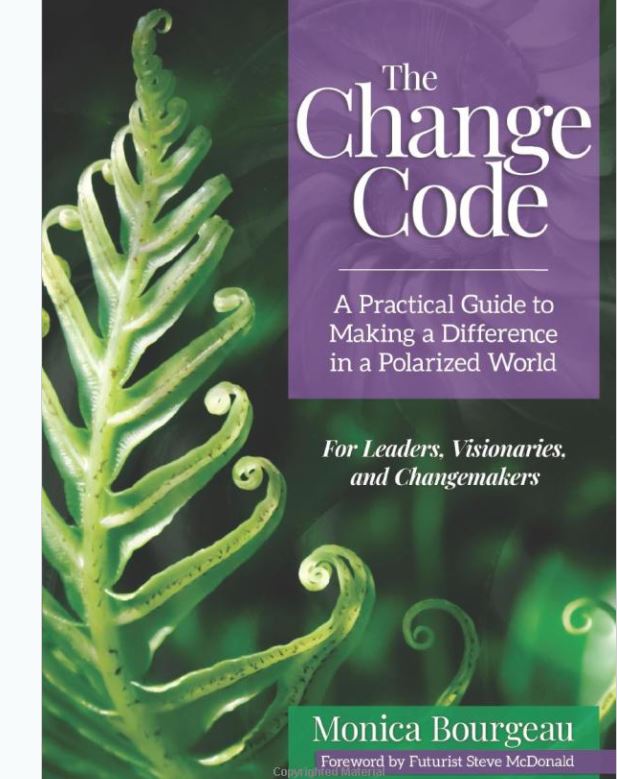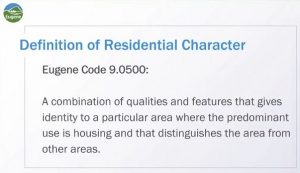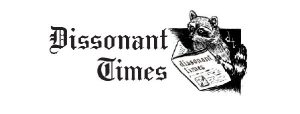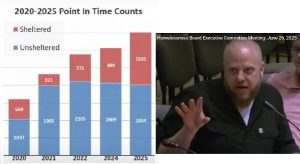LFL Book of the Week: The Change Code by Monica Bourgeau
10 min read
Portland author Monica Bourgeau applies The Change Code to paradigm shifts and societal transformation.
Support your neighborhood Little Free Library. Our LFL book of the week is titled: “The Change Code: A Practical Guide to Making a Difference in a Polarized World, For Leaders, Visionaries, and Changemakers.”
It is written by Portland author Monica Bourgeau. We chatted with Monica about the book, which shares and synthesizes ideas from many exploring the “emergent cyclical theory” of adult human development. We started by talking about a few of the pioneering thinkers, Dr. Clare Graves and Dr. Don Beck, who influenced and inspired her.
Monica Bourgeau: One of my mentors in writing this book is Dr. Don Beck, who is the author of the books on Spiral Dynamics. He knew Clare W. Graves and worked with him to put this theory into textbooks and bring it into the college environment. He used to have his students come to him and say, Dr. Graves, you’ve taught us about all of these different theories about psychology and human development. Which one is the right one? And he really didn’t have a great answer for that.
So that’s what set him out on this journey where he actually uncovered these developmental layers as he was trying to understand human development and what creates basically a healthy human being. And essentially it’s just these developmental stages that we all go through. We all go through the same exact order of layers and we can’t skip them. And so understanding the order and this natural progression is really helpful in understanding where we are today, as well as what is possible for us in the future.
Colors were assigned to these different developmental layers by Dr. Don Beck. And really it’s just to make them easier to understand and easier to follow. People can take a free quiz on my website if they want to see what their primary color is, so they can do that.
Thank you for supporting
local citizen journalism
John Q. Murray: And it sounds like, many teachers have adopted this framework, the open-ended growth to a new layer.
Monica Bourgeau: Yes, absolutely. The theory of Spiral Dynamics is not really that well known, but once you understand the theory, you begin to see it everywhere because it has been so incorporated into other theories and other models that it’s really part of our day-to-day lives, whether we realize it or not.
It applies to societies and it applies to individuals. It applies to companies. Many companies have used it in their development, such as Whole Foods and Southwest Airlines. Tony Robbins actually teaches Spiral Dynamics as part of his training programs. So it’s used pretty broadly and you definitely see it in other speakers and modern day theorists as well in their work.
And it really shows the progression we’ve made as a society. It begins to show the transition from when, as a society, we were hunter-gatherers and we were all individuals out just working for our own survival.
And then we transitioned from red into blue, which is when we started to live in communities and we began to work together. And we realized that there needed to be some rules as a society for us to live together and to cooperate. So these rules began to form in this blue layer. And that’s also when we started to see the church and traditional religion beginning to emerge to provide some of the basis for these societal rules and norms.
And then we began to transition as a society away from this blue model into an orange model, which is very much about science and man conquering the earth and very much into achievement and competition and financial benefit and that’s the primary development layer that we’re in as a society right now. And one thing that to keep in mind too, that’s really important is that as society moves through these layers, that there’s always individuals in all of the developmental layers, but when you have enough people in a layer , society as a whole kind of operates from that perspective. Of course you have people in the society with different views and perspectives as well. And the earlier layers don’t disappear.
So, Ken Wilbur, who’s a prolific writer on this topic, says ideally you transcend and include. So you begin to incorporate these earlier layers, but you develop the capacity to handle more complexity.
And so that is what has happened as we’ve moved through these different layers as society. And now we’re in the midst of kind of this next paradigm shift, which is from the orange to the green layer. So remember when I was talking about orange, I talked about it’s very, science-based, it’s very much in, in conquering the earth and conquering the planet and, putting a man on the moon and medical advances and lots of great technology, the internet and computers and all of those things.
But now we’re starting to see some negative side effects of that because this layer is also very individualistic. And so we’ve seen a huge increase in loneliness. And this was before the pandemic that actually ripples throughout society, we see opioid addictions and suicides and depression and lack of community and lack of connection.
Those are all signs that this layer has gone too far. And our life conditions have simply become more and more complex. And so the solutions that were developed under this orange layer of operating are no longer enough to solve the problems that we face. And I think COVID is a prime example of that, where it’s really a global problem that requires global coordination and some global solutions. We’re starting to see a huge buildup of plastic in the oceans and in our waters. So this mindset of just consumerism and mass consumption is starting to really have some negative effects. And so we need to adjust the way that we’re living in order to evolve and survive as a species. And that’s really what this model kind of helps us do.
And so we’ve started to see the emergence of this green layer and green layer is all about healing. The self, we’ve seen rising coaching and, integrated health care and counseling and mindfulness are starting to go mainstream. A lot of personal growth and development. Those are signs that this green layer is starting to emerge as well as it’s also healing the planet. So we see a lot of initiatives around cleaning up the plastic in the ocean and reducing consumption. All of those types of things are signs that we’re moving into this green layer, which is not individualistic. It’s more communal it’s more working together and helping each other to create a better outcome.
John Q. Murray: The book, it mentions, I think, saying, “Nelson Mandela, give the orange speech, give the blue speech.” And they, the speeches, were coded as they recognize the characteristics of the audience that they were addressing.
Monica Bourgeau: Absolutely. And that’s actually really helpful when you understand the groups that you’re working with because different groups may have different perspectives and they actually view the world through a slightly different lens when you understand these different value systems. So if somebody was really in a red value system they really believe that the strongest will survive. And so that’s framed the message is framed very differently than if you were talking to someone in, at the green layer who believes we should, we’re all equal and we all should work together and find common ground.
It’s just a slightly different way of framing the message. He didn’t change his underlying intent, but he maybe would frame that slightly differently depending on the different groups he was talking to.
Dr. Beck was a tenured professor at a university in Texas. And when he discovered this theory and began working with Graves, he was so passionate about it and saw the potential for really helping to work through some of the world’s most challenging conflicts that he left his position at the university and began to travel the world. And he was fortunate enough to be able to work with Nelson Mandela. And so he shared this theory with Nelson Mandela and they actually used it to help move away from apartheid without a civil war.
Nelson Mandela was keenly aware of the effect of extremism because you have extreme perspectives on both sides and to really begin to move forward, you have to move away from that extremism on both sides of the polarization and the polarity.
And so there’s lots of examples of Nelson Mandela doing that. He called for peace and was quick to identify the extremists on both sides and help bring people together in the middle.
He also used this theory in his messaging to help communicate with groups of people that were in conflict at the time to help them see a shared vision and a shared message. And he did that in the way that he framed the message, based on where they were in this developmental spiral. And it was very effective in helping to end apartheid.
Invictus, a wonderful film, is another concept that he used from spiral dynamics, which is creating a shared goal. He brought the country of South Africa together around creating a winning rugby team. And so that was able to bring these feuding factions together around a common goal.
John Q. Murray: Your book then goes on to provide tools that build community, teach people more how to collaborate and cooperate with one another.
Monica Bourgeau: Yeah, these tools are actually really helpful. And because I was really targeting changemakers, I wanted to provide them with something really tangible that they could use to help reduce the polarization and the scalings of chaos that we’re feeling right now with our political system.
And just seeing a lot of our systems in our society are no longer meeting our needs, but there’s definitely some things that we can do. One of my favorites is polarity mapping because it really helps us understand multiple viewpoints and perspectives and see the benefits of those because pretty much every decision that we make there’s a polarity involved.
So for example, change or not change. So not changing is a connection to the traditional way of doing things. And there’s benefits to both perspectives. And when you take a specific issue and map it out, using this tool that I share in the book, you start to see that there’s definitely benefits for changing, but there’s also some risks with that. And so you begin to have a more kind of balanced perspective and you’re able to see multiple viewpoints, which I think can really help us make some better decisions right now. And began to work together to come up with solutions that work for everyone on the continuum.
John Q. Murray: Once you start seeing it, you can apply it to so many examples.
Monica Bourgeau: One thing I’m excited about right now is I’m actually working on applying the concepts in healthcare. So I’m doing some contracting with some clinics here in Oregon who are creating a new model of healthcare based on this process of, moving to this next level and creating a new way of offering healthcare. Their main goal is really to provide healthcare in places that don’t have access right now. And they’ve created this model already, before me that’s been hugely successful and it’s developed around creating the right culture for the caregivers and, creating a supporting healthy environment for the caregivers. And it’s just taken off and now they’re starting a new clinic.
John Q. Murray: What really struck me was the chapter on the neighborhood. “Our neighborhoods are the primary source of our health. Our safety and security are also tied to community. The environment is a local responsibility. We have the power to build a resilient economy. The food we eat matters. We raise our children locally. Our communities are the site for care.” It’s just incredibly powerful. It it means everyone can participate in this, right now.
Monica Bourgeau: Absolutely. And change really happens with these small decisions and these small everyday actions, You know, a lot of people feel like they want to create this big impact in the world, but it really starts with these just small actions and, being kind to your neighbor and starting to build a community in your own neighborhood. And this is really helpful in the challenges that we’re seeing in society right now, because as I mentioned, one of the negative side effects of being in the orange layer too long is we see this extreme individualism that results in depression and isolation and a feeling of not belonging and not connecting.
And so the way we move through that, and really the solution is by creating community and by creating connection. And that’s how we began to move out of this chaotic period of time that we’re in right now is by creating those communities.
John Q. Murray: How can people learn more about your book obtain your book and maybe attend some conferences
Monica Bourgeau: I have a website for the book. It’s TheChangeCode.net. And it’s available on all of the major online retailers, Amazon, Barnes and Noble.com. It’s also available within the state of Oregon at Powell’s bookstore and New Renaissance bookstore, local places like that as well, that really appreciate the business.
And then I do have a couple of upcoming talks. CaritasCenter.org, at the end of the month. And then I’m putting one together for New Renaissance bookstore for March. You can also follow The Change Code on Facebook. So if you consider yourself a changemaker and a visionary that wants to create a positive difference, you can join us in the Facebook group as well, https://www.facebook.com/thechangecodebook.



